Higgs Boson Physics
Higgs boson discovery!
Two of the most intriguing mysteries of nature are electroweak symmetry breaking (EWSB) and the origin of fundamental particle mass. In the SM, the weak and electromagnetic forces have the same strength at very high energy (e.g. as existed in the very early Universe) described by single electroweak interaction and particles must be massless to preserve gauge invariance in which different configurations of the fields lead to identical physics results. Gauge invariance is a required ingredient of any quantum field theory describing Nature, otherwise calculated values of physically measurable quantities (e.g. the probability of two W bosons scattering at high energy) can be infinite. Since we know through observation that the electromagnetic force is much stronger than the weak force, electroweak symmetry is a broken symmetry. We also know that most fundamental particles have mass, including the weak force carriers (W and Z) which are very massive (83 and 90 times heavier than a proton, respectively) and therefore short-ranged.

Harder to answer in detail are the following questions: “What is the agent of EWSB?” and “What is the origin of particle masses?” The pursuit of answers to these questions and the search for new physics beyond the SM, especially novel use of the Higgs boson as a new tool in these searches, are primary thrusts of my current research.
The SM provides a mechanism, adopted from work in condensed matter theory and following Occam’s Razor logic, for electroweak symmetry breaking and generating masses of fundamental particles without violating gauge invariance. Particle masses arise when the electroweak symmetry is spontaneously broken by the interaction of massless fields with the “Higgs field” an invisible spinless field that permeates all space and has a non-zero value everywhere, even in its lowest energy state. If the SM description of EWSB is correct, then a single massive, neutral, spinless particle called the “Higgs boson” must exist.
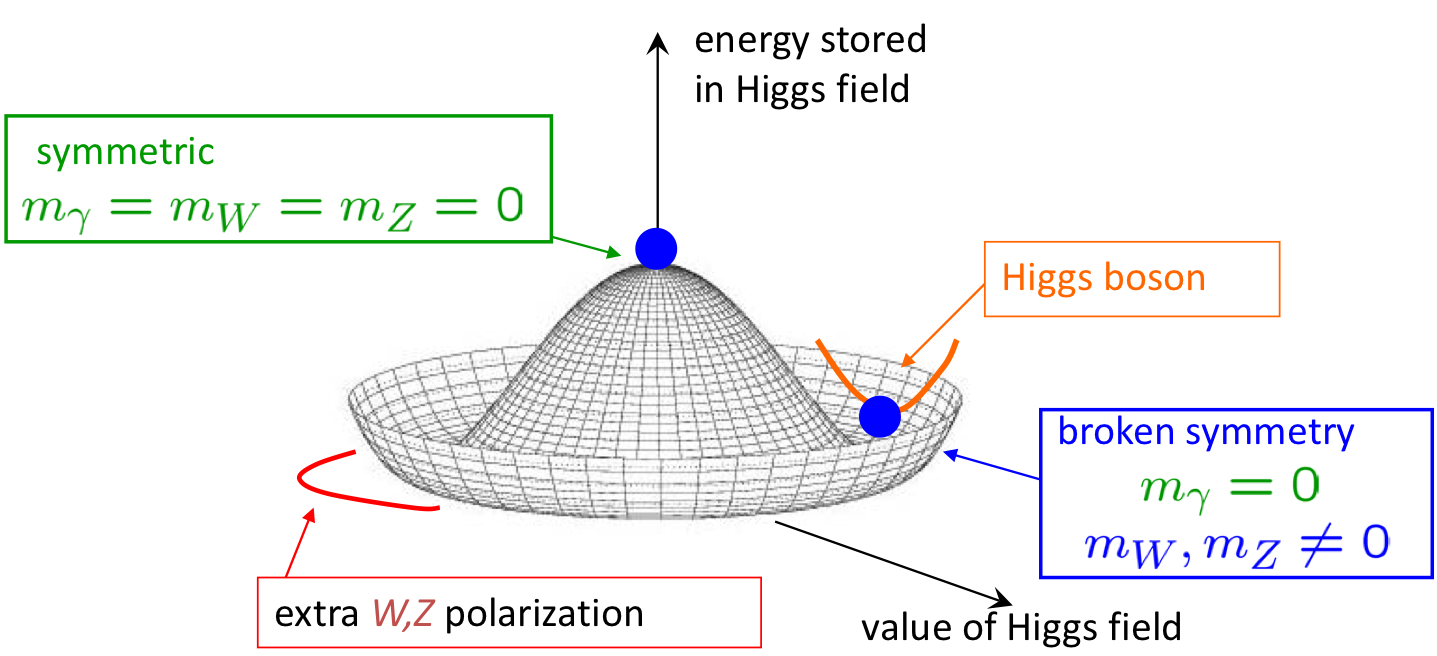
Higgs Boson Discovery
The Higgs boson can be produced and decay at the LHC in a variety of interesting ways, depending on its mass. The figure below shows the production and decay characteristics for a Higgs boson with a mass of 126 GeV:
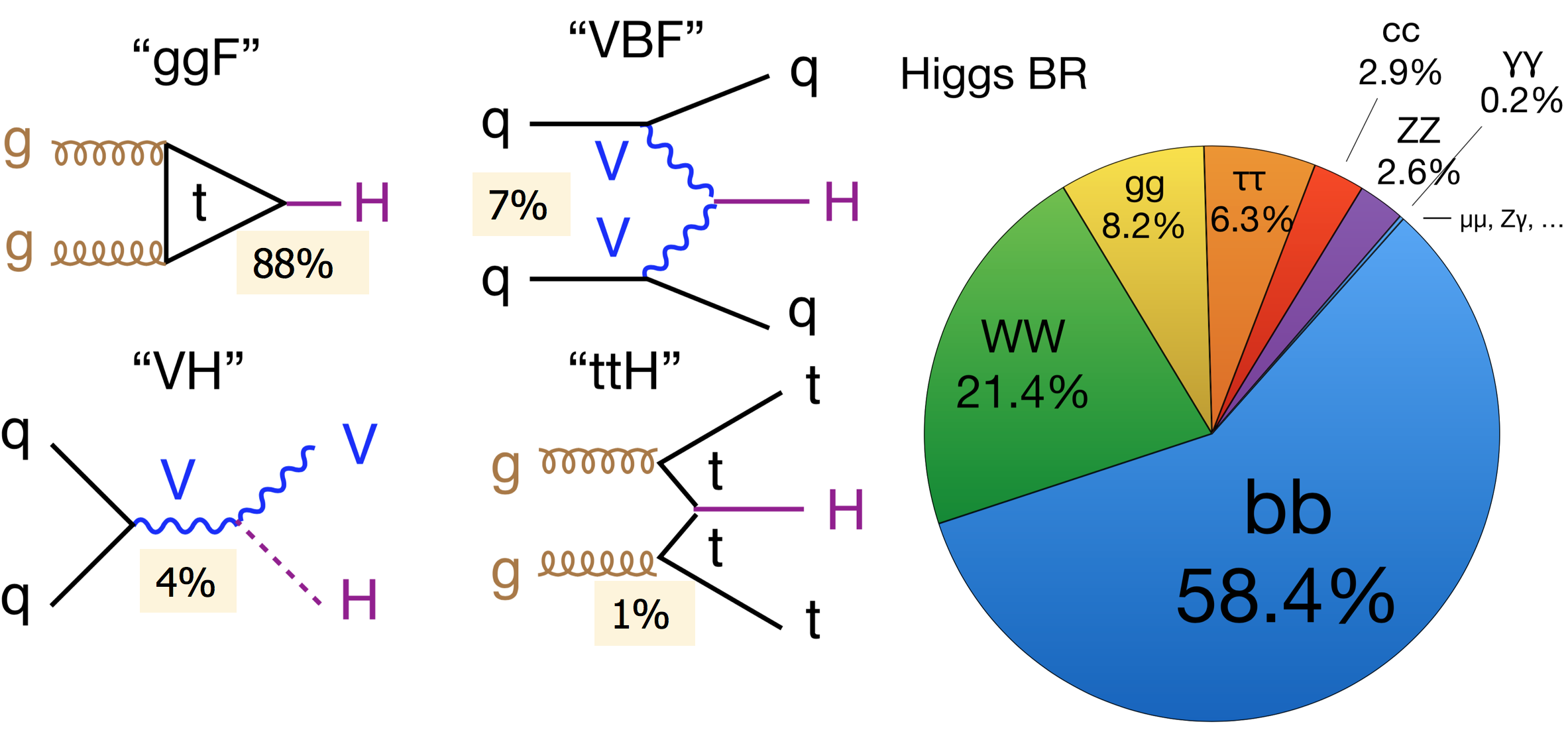
In 2012, the ATLAS and CMS experiments announced the discovery of a Higgs boson h. This discovery lead to the 2013 Nobel Prize in Physics for a theoretical prediction of the Higgs boson. My group contributed to the Higgs boson discovery (5.9σ) PLB 716 (2012) 1 through analysis of the h→WW* channel.
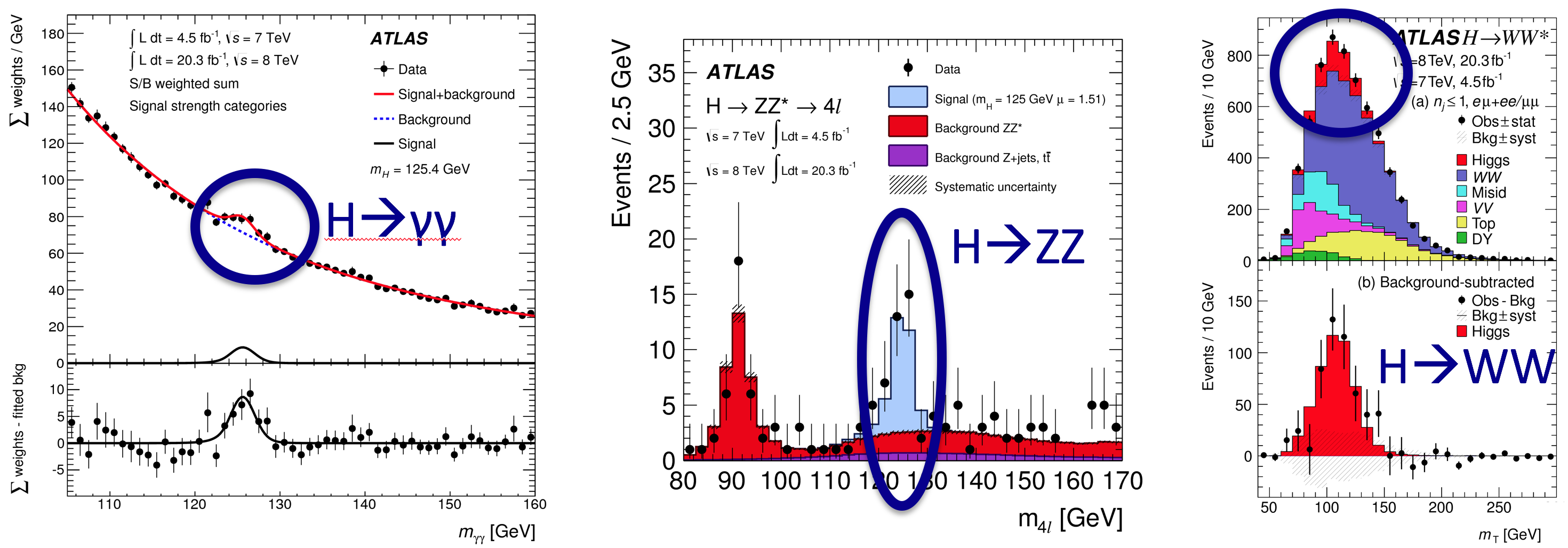
The Higgs boson discovery generated a great deal of excitement in the HEP Community:
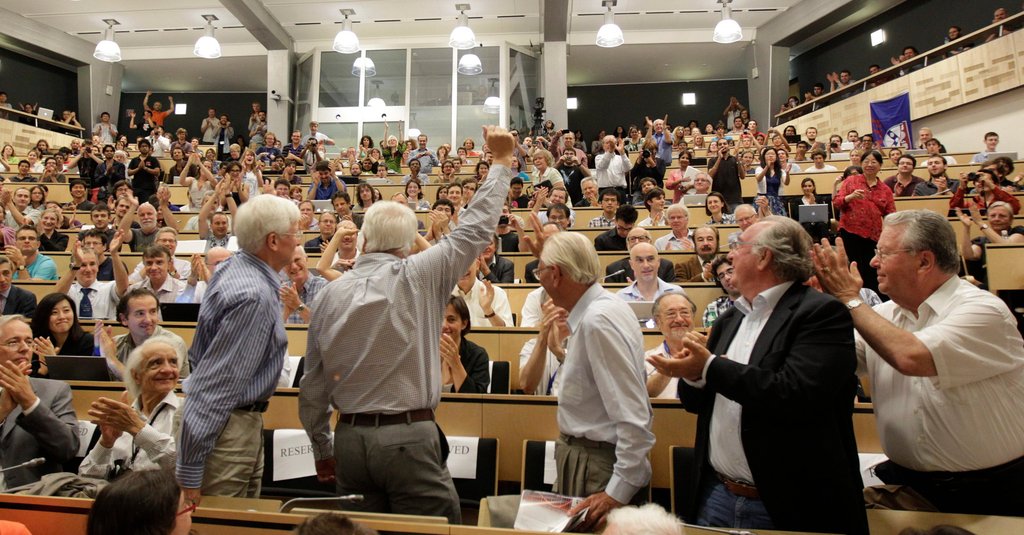
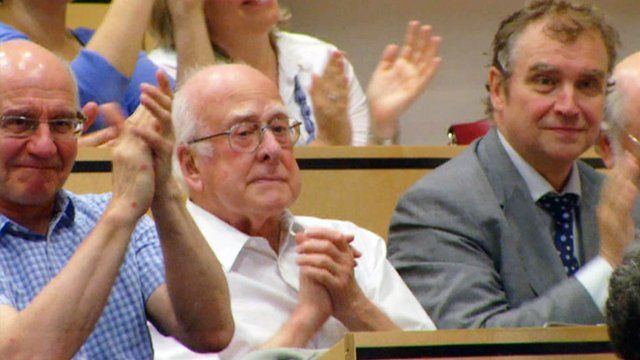
and captured the attention of the world to the marvel at power of particle accelerators to uncover fundamental aspects of our subatomic world. Below you can find a Youtube video of the Higgs boson discovery that I presented to the University of Illinois Physics Department in July 2012:
Since the 2012 discovery, these signals continue to grow with integrated luminosity as one would expect for the signal from a real particle. In 2018 using 36 fb-1 of 13 TeV collision data, the invariant mass distributions look like:
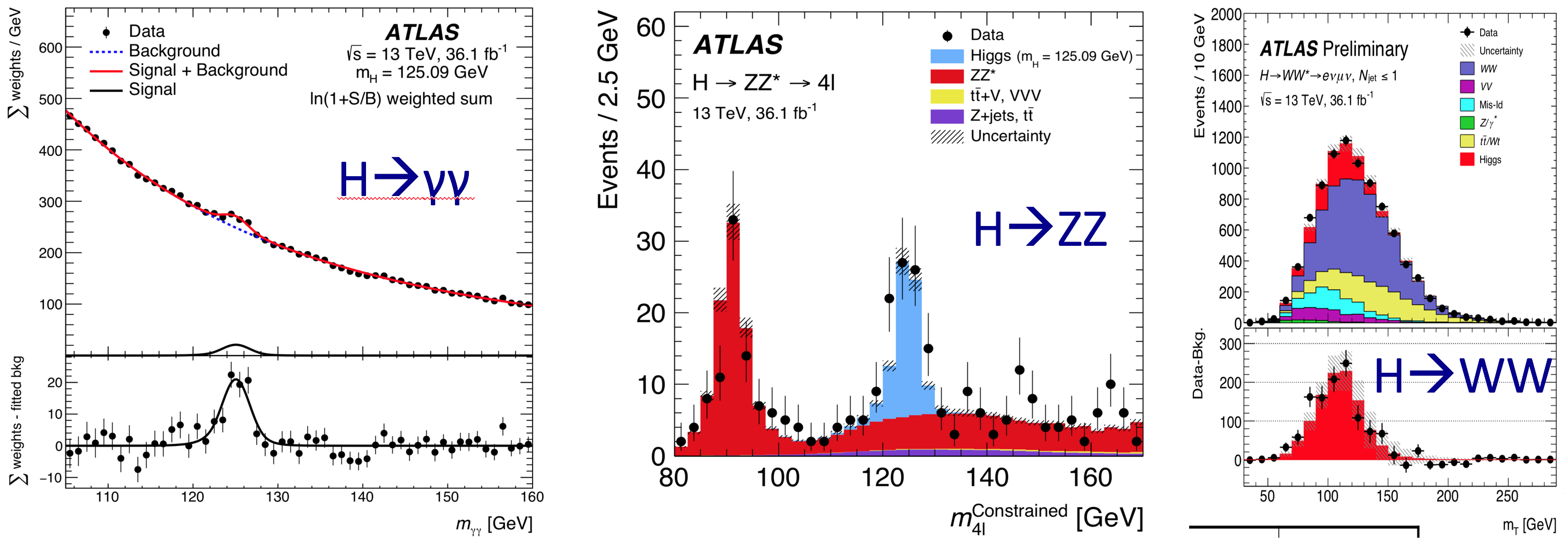
Observation of h→WW* and Measurement of Higgs Boson Couplings
Observation and measurement of Higgs boson decays to WW* with the ATLAS detector
My group contributed to the h→WW* observation (6.1σ) PRD 92 (2015) 012006, providing the most precise single-channel measurement of Higgs boson couplings. My former graduate student Philip Chang (now a postdoc at UCSD) received the 2014 US ATLAS Graduate Student Achievement Award for his Ph.D. thesis work on the h→WW* observation and the Higgs boson couplings measurements.
Search for Exotic Higgs Decays
The discovery of the Standard Model (SM) Higgs boson has opened up new avenues to search for physics beyond the SM (BSM) with perspectives to search for non-SM or “exotic” decays of the Higgs boson. Such searches could provide unique access to hidden-sector particles that are singlets under the SM gauge transformations. Exotic decays of the Higgs boson are predicted by many new-physics models, including those with an extended Higgs sector, dark matter (DM) models, models with a first-order electroweak phase transition and theories with neutral naturalness. These models have also been used to explain the observations of a γ-ray excess from the galactic centre (GC) by the Fermi Large Area Telescope. For example, a model for the GC γ-ray excess was proposed in which 30 GeV DM particles pair-annihilate dominantly through a CP-odd scalar mediator that subsequently decays into SM fermions. If the mediator is sufficiently lighter than the SM Higgs boson (H) then H decay into the mediator pair can be observed at the LHC.
Existing measurements constrain the BSM or “exotic” branching ratio (B) of the 125 GeV Higgs boson decays to less than approximately 34% at 95% confidence level. Due to the narrow width (∼ 4 MeV) of the Higgs boson, even a small non-SM coupling of O(10−2) can lead to O(10%) branching ratio into BSM states. This potentially large B(H → BSM states) motivates direct searches for exotic H decays. Searches for the Higgs boson with a mass of 125 GeV decaying into two spin-zero particles, H → aa, have been performed in various final states in ATLAS and CMS. The analysis presented in this Letter performs the search in the bbμμ final state. The a-boson can be either a scalar or a pseudo-scalar under parity transformations, since the decay mode considered in this search is not sensitive to the difference in coupling. Assuming that the a-boson mixes with the SM Higgs boson and inherits its Yukawa couplings to fermions, the largest branching ratio is expected to be to the heaviest fermions accessible by kinematics (2ma < mH ), where ma and mH are the a-boson and Higgs boson masses. For ma 10 GeV this means the a-boson would decay preferentially into bb. However, in models with enhanced lepton couplings such as the Type-III 2HDM, the a → μμ branching ratio can also be relatively large. Additionally, the sensitivity of a given channel does not depend only on the expected signal rate in a particular model, but also on the efficiency for triggering and reconstructing events of interest. The presence of a clean di-muon resonance provides a distinctive signature that can be used for triggering and precision mass reconstruction, which helps to suppress background.
This analysis was started in ATLAS by my former graduate student Philip Chang (now a postdoc at UCSD). Chang implemented a kinematic likelihood fitting approach proposed by Neubauer for h→aa searches which exploits the symmetry of h→aa decays to improve the mass resolution and suppress top and Drell-Yan backgrounds, as described in Ph.D. thesis. Applying this kinematic fitting technique dramatically improves the signal-to-background in the signal region, as shown in the figure below:
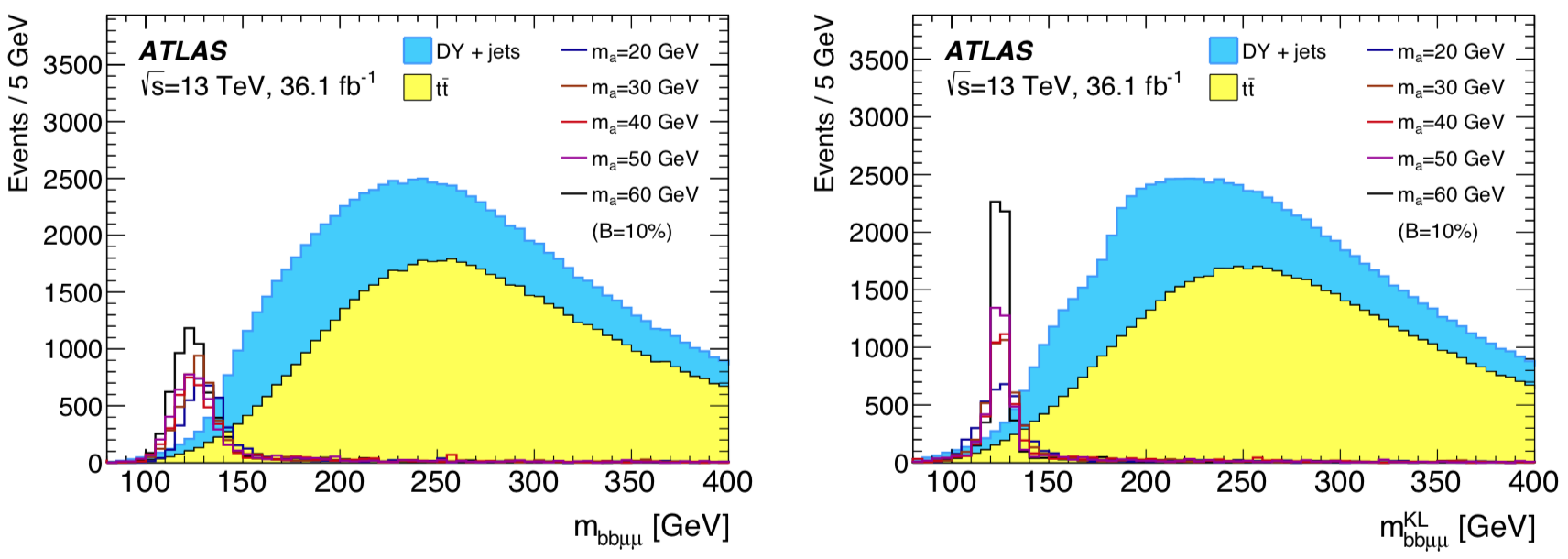
We began to work together with J. Hobbs’ group at Stony Brook University early on in this analysis, and this collaboration lead to a paper submitted to PLB in early July 2018. Below shows a summary of the limits on exotic Higgs decays obtained:
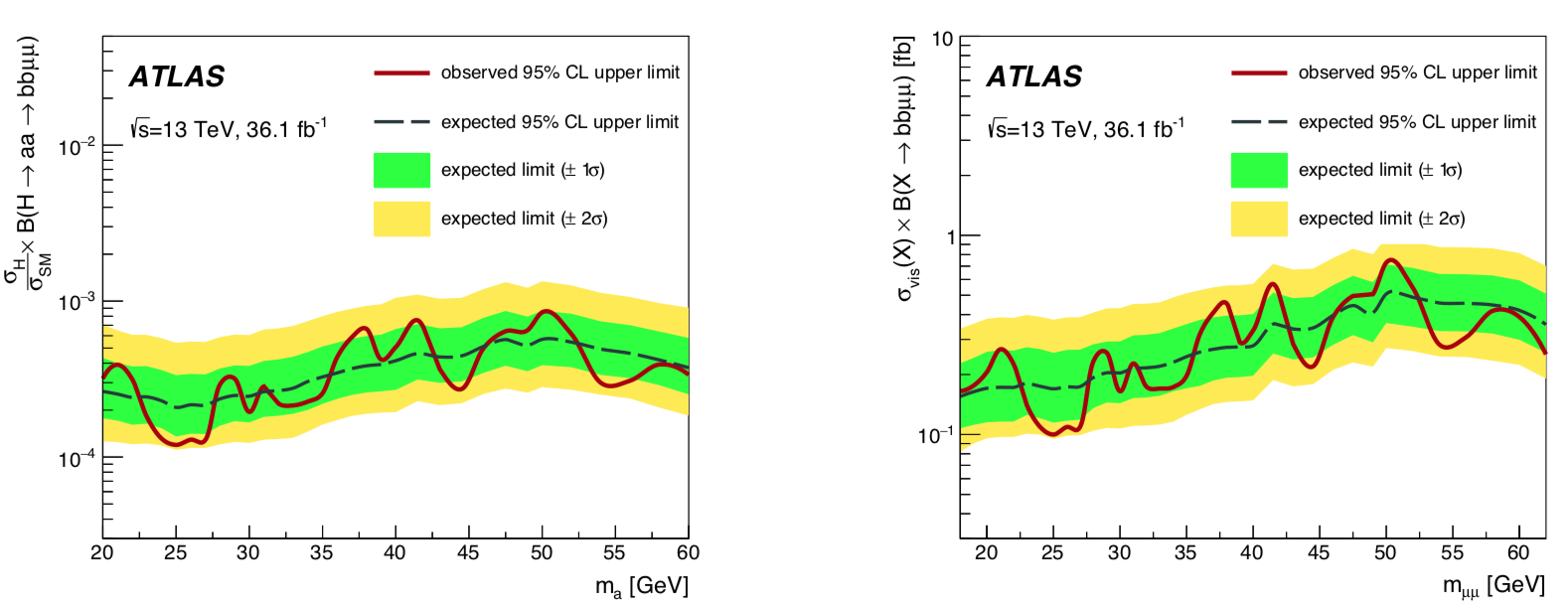
Constraints on Charged Higgs Bosons
Charged Higgs bosons (H+) often arise in new physics models with an extended Higgs sector such as Supersymmetry. Through the work of Allison McCarn Ph.D. thesis (now at Southern Methodist University) and Anna Sfyrla (now at University of Geneva), my group lead searches for H+→tau+nu in top pair events using a direct mass reconstruction method JHEP 1206 (2012) 039 and via an apparent violation of lepton universality JHEP 1303 (2013) 076.
Further Reading
- G. Aad et al. [ATLAS Collaboration], “Observation of a new particle in the search for the Standard Model Higgs boson with the ATLAS detector at the LHC”, Phys. Lett. B716 (2012)
- G. Aad et al. [ATLAS Collaboration], “Observation and measurement of Higgs boson decays to WW* with the ATLAS detector”, Phys. Rev. D92 (2015)
- M. Aaboud et al. [ATLAS Collaboration], “Search for Higgs boson decays into a pair of light bosons in the bbμμ final state in pp collision at s√=13 TeV with the ATLAS detector”, arXiv:1807.00539
- G. Aad et al. [ATLAS Collaboration], “Search for H+ through the Apparent Violation of Lepton Universality in top-pair events using pp collisions at √s=7 TeV with the ATLAS detector”, JHEP 03, 76 (2013)
- G. Aad et al. [ATLAS Collaboration], “Search for charged Higgs bosons decaying via H+→tau+nu in top quark pair events using pp collisions at √s=7 TeV with the ATLAS detector”, JHEP 1206, 039 (2012)
